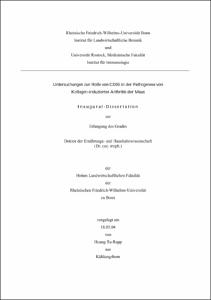Untersuchungen zur Rolle von CD95 in der Pathogenese von Kollagen-induzierter Arthritis der Maus

Untersuchungen zur Rolle von CD95 in der Pathogenese von Kollagen-induzierter Arthritis der Maus

| dc.contributor.advisor | Goerlich, Roland | |
| dc.contributor.author | Tu-Rapp, Hoang | |
| dc.date.accessioned | 2020-04-06T15:07:03Z | |
| dc.date.available | 2020-04-06T15:07:03Z | |
| dc.date.issued | 2004 | |
| dc.identifier.uri | https://hdl.handle.net/20.500.11811/2011 | |
| dc.description.abstract | Kollagen-induzierte Arthritis (CIA) - ein Mausmodell für rheumatoide Arthritis (RA) - ist eine chronisch entzündliche Erkrankung, die Eigenschaften aufweist, die der RA sehr ähneln. Zu diesen Ähnlichkeiten gehören u. a. Polyarthritis, Synovitis und als Folge davon Knorpel- und Knochenzerstörung. Die synoviale Hyperplasie ist dabei ein besonderes Kennzeichen der Gelenkzerstörung. Bisher sind die Auslöser für dieses Phänomen unbekannt. Es gibt jedoch Hinweise, die auf ein gestörtes Gleichgewicht von Zellproliferation und Zelltod (Apoptose) hindeuten. Apoptose wird durch die Bindung des CD95-Liganden an das Transmembranprotein CD95 (Fas) induziert. Jedoch wurde auch ein anti-apoptotischer Effekt von CD95 beobachtet. Darüber hinaus wird die lösliche Form von CD95 (sFas) als potenzieller Antagonist für CD95-vermittelte Apoptose diskutiert. So wurde sFas in hoher Konzentration im Synovium und im Serum von Patienten mit RA nachgewiesen. Diese Beobachtungen weisen auf die wichtige Rolle von Fas im Erkrankungsprozess der RA hin. Um die Rolle von Fas in der Pathogenese von RA zu untersuchen, wurde das Mausmodell CIA eingesetzt. Dazu wurden Fas-mutante (DBA/1J-lpr/lpr) und sFas-transgene (sFas-DBA/1J) Mäuse mit Rinderkollagen II und komplettem Freunds Adjuvans immunisiert und die Suszeptibilität, CIA zu entwickeln, untersucht. Trotz verstärkter Immunantwort auf Rinderkollagen II entwickeln DBA/1J-lpr/lpr-Mäuse eine statistisch signifikant schwächer ausgeprägte Arthritis mit einer niedrigeren Inzidenz als ihre Kontrollen. sFas-DBA/1J-Mäuse zeigten dagegen einen ähnlichen Verlauf der Erkrankung wie ihre Kontrollen trotz erhöhter Immunantwort und veränderter Suszeptibilität gegenüber Fas- und Aktivierungs-induzierter Apoptose. Darüber hinaus waren die kritischen pro-inflammatorischen Zytokine wie der Tumornekrosefaktor-α (TNF-α) und die Interleukine-6 und -1β (IL-6, IL-1β) in den Pfoten der DBA/1J-lpr/lpr-Mäuse zum Zeitpunkt des Krankheitsbeginns erhöht, was auf die geringe Aktivierungseffizienz dieser Zytokine bei Fas-Mangel hindeutet. Dennoch zeigte die Mausfibroblasten-Zell-Linie NIH3T3 eine geringe Empfindlichkeit gegenüber anti-Fas-Antikörper-induzierter Apoptose und eine erhöhte Expression von pro-inflammatorischen Zytokinen nach Fas-Ligation. Diese Beobachtungen zeigen, dass eine gestörte Immuntoleranz nicht zu einer verstärkten Suszeptibilität für CIA führt, und dass Fas durch seine stimulierende Wirkung auf lokale Zellen, insbesondere auf die Synovialfibroblasten, eine Rolle in Zerstörungsprozessen im CIA-Synovium spielt. Darüber hinaus gibt es ein empfindliches Gleichgewicht zwischen löslichem und transmembranem Fas und zwischen dem apoptotischen und dem stimulierenden Fas-Pathway. Dessen Regulation könnte wichtig für Autoimmunerkrankungen sein. | en |
| dc.description.abstract | Studies of the role of CD95 in the pathogenesis of murine collagen-induced arthritis Collagen-induced arthritis (CIA), the animal model of rheumatoid arthritis (RA), is a chronic inflammatory disease bearing all the hallmarks of RA like e.g. polyarthritis, synovitis, and subsequent cartilage/bone erosions. One feature of the disease thought to contribute to joint damage is synovial hyperplasia. Factors contributing to this phenomenon are unknown, however, imbalance between rates of cell proliferation and cell death (apoptosis) has been suggested. Apoptosis is induced by interaction of CD95-ligand and CD95 (Fas), a transmembrane protein. However, an anti-apoptotic effect after Fasligation has previously been observed. In addition, it has been discussed, that the soluble form of CD95 (sFas) has protecting features against Fas-mediated apoptosis. Increased sFas was found in synovial fluids and sera of patients with RA. These observations suggest a role of Fas in the disease process of RA. To evaluate the role of Fas in the pathogenesis of CIA we determined the susceptibility of Fas-mutant mice (DBA/1J-lpr/lpr) and of soluble Fas transgenic mice (sFas-DBA/1J) to CIA. Disease was induced by immunizing mice with bovine type II collagen (CII) in complete Freund’s adjuvant. Contrary to expectation, DBA/1J-lpr/lpr mice developed statistically significant milder disease with lower incidence than the control mice in spite of increased immune responses to CII. On the other hand, sFas-DBA/1J mice developed CIA with mean date of onset and an average score comparable to their control littermates despite increased immune response and impaired susceptibility to Fas- and activationinduced apoptosis. Furthermore, the critical pro-inflammatory cytokines like tumor necrosis factor-α (TNF-α), interleukin-6, and -1β (IL-6, IL-1β) were increased in DBA/1J-lpr/lpr mouse paws on the onset of disease despite of milder arthritis suggesting less efficient activation through these cytokines when Fas signalling is deficient. In addition, synovial fibroblast was stimulated by interaction with anti-Fas antibody as evidenced by the expression of pro-inflammatory cytokines and less susceptibility to anti-Fas-induced apoptosis in mouse fibroblast cell line NIH3T3. These observations clearly show that tolerance impairment does not lead to enhanced susceptibility to CIA and that Fas contributes to damage in CIA synovium by inducing proliferation of local cells, in particular synovial fibroblasts. Furthermore, there is a delicate balance between the soluble and membrane form of Fas and the apoptotic and stimulatory Fas pathways. The regulation of this balance may be important to autoimmune diseases. | en |
| dc.language.iso | deu | |
| dc.rights | In Copyright | |
| dc.rights.uri | http://rightsstatements.org/vocab/InC/1.0/ | |
| dc.subject | Apoptose | |
| dc.subject | Autoimmunität | |
| dc.subject | Kollagen-induzierte Arthritis | |
| dc.subject.ddc | 570 Biowissenschaften, Biologie | |
| dc.title | Untersuchungen zur Rolle von CD95 in der Pathogenese von Kollagen-induzierter Arthritis der Maus | |
| dc.type | Dissertation oder Habilitation | |
| dc.publisher.name | Universitäts- und Landesbibliothek Bonn | |
| dc.publisher.location | Bonn | |
| dc.rights.accessRights | openAccess | |
| dc.identifier.urn | https://nbn-resolving.org/urn:nbn:de:hbz:5N-04602 | |
| ulbbn.pubtype | Erstveröffentlichung | |
| ulbbnediss.affiliation.name | Rheinische Friedrich-Wilhelms-Universität Bonn | |
| ulbbnediss.affiliation.location | Bonn | |
| ulbbnediss.thesis.level | Dissertation | |
| ulbbnediss.dissID | 460 | |
| ulbbnediss.date.accepted | 19.11.2004 | |
| ulbbnediss.institute | Landwirtschaftliche Fakultät : Institut für Landwirtschaftliche Botanik | |
| ulbbnediss.fakultaet | Landwirtschaftliche Fakultät | |
| dc.contributor.coReferee | Schellander, Karl |
Files in this item
This item appears in the following Collection(s)
-
E-Dissertationen (1096)




